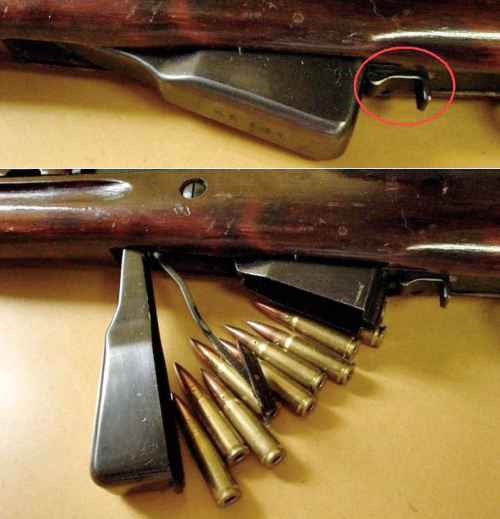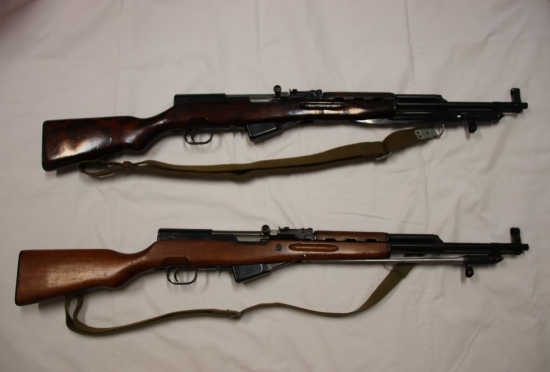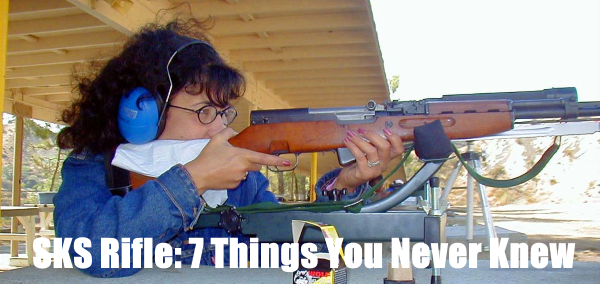The SKS rifle was an integral weapon during the height of the Cold War.
The Soviet-manufactured assault rifle was a favorite among allied forces of the Eastern Bloc.
It’s distinguished by a hinged, fixed 10-round magazine along with a folding bayonet.
The SKS rifle eventually was distributed to the United States where it’s noteworthy among collectors.
It’s a grandfather to modern assault rifles establishing a precedent in several regards.
Discover 7 Things You Should Know about the SKS Rifle, below.
Table of Contents
#1. SKS Rifle History

The SKS rifle was first developed in 1945.
It’s a semi-automatic weapon that was designed by Russian Sergei Gavrilovich Simonov.
At first, the SKS rifle was only available in the Soviet Union.
Eventually, however, several other nations (including China) began importing the self-loading carbine.
For this reason, the SKS carbine became a favorite among insurgent forces allied with the Eastern Bloc.
The assault rifle was favored among troops for being lightweight and practical in guerrilla warfare.
Notwithstanding, the SKS rifle did feature several limitation that eventually designated it obsolete by the Soviet Armed Forces in the 1950s.
Eventually, the SKS was replaced by the AK-47 which features a larger magazine as well as select-fire capability.
Be that as it may, the SKS rifle remain active with several other military units for decades.
The initial Soviet production created 2.7 million SKS carbines.
Then, in the late-1980s, millions entered the civilian market of North America.
As a result, the SKS rifle remains popular among certain sporting groups.
#2. Design

The SKS rifle is distinguished by a hinged, fixed magazine and permanently attached bayonet.
Otherwise, the semi-automatic carbine features a conventional layout with wood stock and pistol grip.
The barrel is chrome-lined which increases heat and wear tolerance.
Moreover, the chrome-line barrel is able to resist corrosion without impacting precision.
The SKS rifle is equipped with a bayonet that is attached to the underside of the barrel.
It extends or retracts depending on need with both blade and spike bayonet models available.
The gas-operated rifle features a spring-loaded bolt carrier and gas piston operating rod.
The 2 components function together to trigger a reaction as well as feeds a new round from the magazine to the chamber.
These developments contributed to the rifle being recognized as one of the first great assault rifles.
Assault rifles are noteworthy for being shorter and lighter than traditional, long-range semi-automatic weapons.
Thus, the SKS rifle was a major innovation over previous firearms such as the Soviet SVT-40.
Nevertheless, there are a few design flaws with the SKS carbine.
For starters, most SKS designs feature a free-floating firing pin within the bolt.
Due to the design, it’s vital that gun handlers take special care during cleaning the firearm.
Why?
The SKS rifle is prone to “slamfires” – or accidental discharges of the rifle without pulling trigger.
The issue of slamfires is especially problematic for collectors which is why special care is an important reminder.
All in all, the assault rifle is straightforward to field strip and reassemble, making it easier to maintain.
#3. Purpose of SKS Rifle
World War II presented all types of new challenges for warfare.
In many regards, military innovation was soaring from developments in aviation to firearms.
During WWII it became apparent that existing long-range rifles were ineffective for most conditions of warfare.
In general most firefights took place between 110-330 yds which influenced the development of lethal, short-range assault rifles.
As a result, the Soviet Union responded with the SKS rifle while the U.S. answered with the M1 carbine.
The SKS carbine is inspired by the AVS-36 in terms of layout.
However, the SKS features a vastly different bolt mechanism (which remains the defining feature of the assault rifle).
Moreover, the caliber, size, magazine, and bolt lockup are also noticeably different.
The SKS rifle also borrows from the M44 as both rifles feature the same carbine and integral bayonet.
For these reasons, the Soviet Army officially adopted the SKS rifle into service starting in 1949.
Eventually, the AK-47 would replace the SKS rifle yet these types of carbines remain active throughout the world.
In fact, ceremonial Russian honor guards still use the SKS carbine similar to how the U.S. Armed Forces regard the M14.
Despite being far less known compared to the AK-47, the SKS is still found in civilian homes along with insurgency groups.
SKS rifle variants (more information, below) have been circulated in 70 different countries across the globe.
Related Article – Best AK-47 Rifle Variants
#4. Military Use
The SKS rifle has an ironic history in terms of military use.
At the time of development, the SKS carbine was groundbreaking for many of its designs.
However, a few years later, Soviet forces would determine the SKS rifle obsolete compared to the AK-47.
Nevertheless, the SKS carbine officially entered Soviet service in 1949.
The semi-automatic rifle was crucial serving troops during the 1956 Hungarian Revolution.
The glory in the Soviet Union, however, was short lived as the popularity with the SKS transformed to allied nations.
Members of the Eastern Block (such as the People’s Republic of China) utilized the SKS carbine heavily during the Cold War.
In fact, production of SKS rifles continued for years in China after manufacturing ceased in the Soviet Union.
Furthermore, the SKS carbine was a standard service rifle for Egypt and Yugoslavia.
Later, the assault rifle would become a popular weapon among left-wing guerilla movements supported by China and the Soviet Union.
The arms transfer was a major upgrade for separatist movements that had previously only had bolt-action rifles in the past.
In fact, the Viet Cong was heavily armed with the SKS rifle during the Vietnam War.
Additionally, the SKS was utilized by insurgent armies that overthrew colonial rule in Angola, Rhodesia, and South West Africa.
Still, by the early 1980s the SKS carbine was largely superseded by the AK-47 and another generation of assault rifles.
#5. Magazine Capacity

The SKS rifle is a semi-automatic weapon with a rate of fire of 35-40 rounds per minute.
The 7.62x39mm cartridge and box magazine features a 10-round stripper clip.
Operators have the choice of loading the box magazine by hand or via the stripper clip.
Meanwhile, cartridges stored in the magazine are removable by pulling back on the latch (near the trigger guard).
In military use, the stripper clips are generally disposable yet can also be reloaded and reused.
The short stroke gas piston, tilting bolt, self-loading action of the SKS was innovative for the time period.
Thus, the carbine continues to feature a higher muzzle velocity compared to firearms designated to replace it (like the AK-47).
In terms of mass, the SKS semi-automatic carbine weighs 8.5 lbs.
#6. Range & Accuracy
The SKS rifle is effective at a firing range of 440 yards.
Its muzzle velocity 734 m/s (2,411 ft/s) is extremely powerful for its time of conception.
The chrome-plated barrel extends to 20 inches on the 520 mm and 22 inches on the M59/66.
Furthermore, the SKS carbine features a front and rear sight.
The front sight is mounted on a hooded post while the rear sight is an open notch.
The sights are adjustable for elevation from 110 – 1,090 yards.
Moreover, the SKS rifle features an all-purpose battle setting on the sight ladder that is set at 330 yards.
#7. SKS Rifle Variants

The SKS carbine was initially designed by the Soviets before transferring hands to several allied nations.
The rifle played an important role during the Cold War being a player in various insurgencies and conflicts.
Moreover, the Soviet Union was willing to share its design with allies leading to numerous variants.
The range of SKS rifle variants is extensive including flip-up night sights and muzzle-mounted grenade launchers.
SKS carbines were also produced in China, Yugoslavia, North Korea, East Germany, Albania, and North Vietnam.
The majority of variants look similar aside from the Yugoslavian version (22mm grenade launcher) and Albanian version.
Despite being in the hands of the enemy for so long, SKS rifles are now popular among U.S. citizens.
The iconic assault rifle is popular among gun collectors as well as veterans of Vietnam.
For this reason, the SKS design ranks 9th all-time for most produced self-loading rifle.
Conclusion: SKS Rifle – 7 Things You Should Know
The SKS is worth considering among the fathers of assault rifles.
It was created shortly after the end of World War II when innovations in warfare were frequent.
There was a pressing need to produce an assault rifle that was lighter and accurate in close combat.
For this reason, the Soviet Union designed the SKS rifle and the rest was history.
The SKS carbine has been seen in nearly 70 countries and numerous conflicts even if its tenure in the Soviet Union was short.
The rifle was instrumental during the Cold War altering the direction of many countries, including China and Vietnam.
Today, its design has been exported to various countries around the globe including North America.
The SKS rifle is popular among gun collectors along with veterans of the Vietnam War.
- 10 Best Tactical Vests - June 24, 2024
- 7 Best Tactical Fanny Packs For Concealed Carry - June 20, 2024
- 10 Best Military Tactical Sunglasses - June 20, 2024


